Small form factor PC building has always captured my imagination, but the compromise between size and performance often feels too steep. That’s why I was particularly excited when the Minisforum BD790i X3D landed on my desk for testing.
After spending some time putting this unique mini-ITX motherboard through its paces, I’m ready to share my findings on this fascinating piece of hardware that’s blurring the lines between mobile and desktop computing.
In my previous reviews, I’ve covered similar products from Minisforum, but this X3D variant brings something special to the table – AMD’s acclaimed 3D V-Cache technology in a compact form factor.
Let’s dive in and see if this mini-ITX marvel delivers on its promises for SFF enthusiasts and gamers alike.
Overview and Specifications
The Minisforum BD790i X3D arrived in a compact box containing the motherboard itself with the pre-installed CPU and cooler, mounting hardware for a 120mm fan, and the rear I/O plate.
Since this is a barebones unit, I needed to add my own memory, storage, and cooling fan before putting it to work.
What immediately stands out about the BD790i X3D is the potent combination of a high-end mobile CPU with desktop-class connectivity.
The Ryzen 9 7945HX3D is a beast with its 16 cores, 32 threads, and a whopping 128MB of L3 cache thanks to AMD’s 3D V-Cache technology.
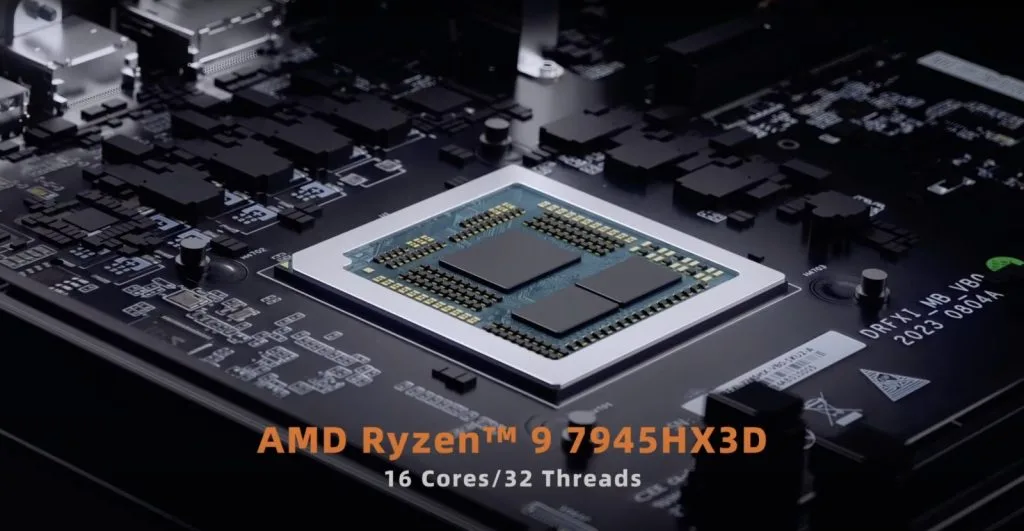

Design and Build Quality
The BD790i X3D features an understated black PCB design that I find quite appealing.
The build quality feels solid and premium, with no flexing or concerning issues when handling the board.
What immediately caught my attention was the substantial heatsink covering the pre-installed Ryzen 9 7945HX3D processor.
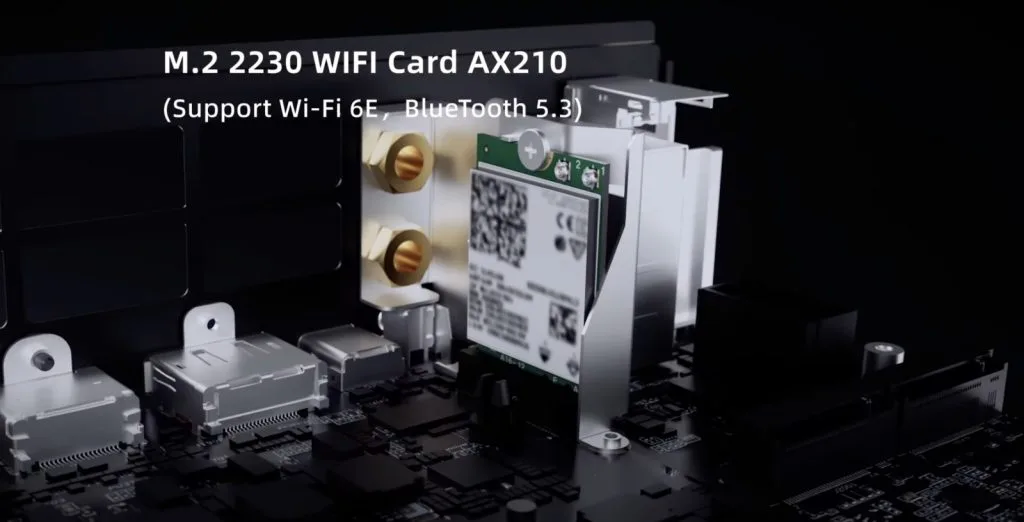

It’s a chunky piece of metal with mounting points for a 120mm fan, which is necessary for keeping this powerful chip cool.
Another notable design element is the active cooling solution for the dual PCIe 5.0 M.2 slots. Unlike many motherboards that use passive heatsinks, Minisforum has included a small fan to ensure those blazing-fast Gen 5 SSDs don’t thermal throttle under load.
Interestingly, several users have reported unplugging or completely removing this small M.2 fan for quieter operation without significant thermal issues.
While this approach may increase SSD temperatures (especially with PCIe 5.0 drives), the main heatsink and system fan often provide sufficient cooling for most workloads.
The rear I/O is well-appointed for a mini-ITX board, though I would have appreciated a few more USB ports.
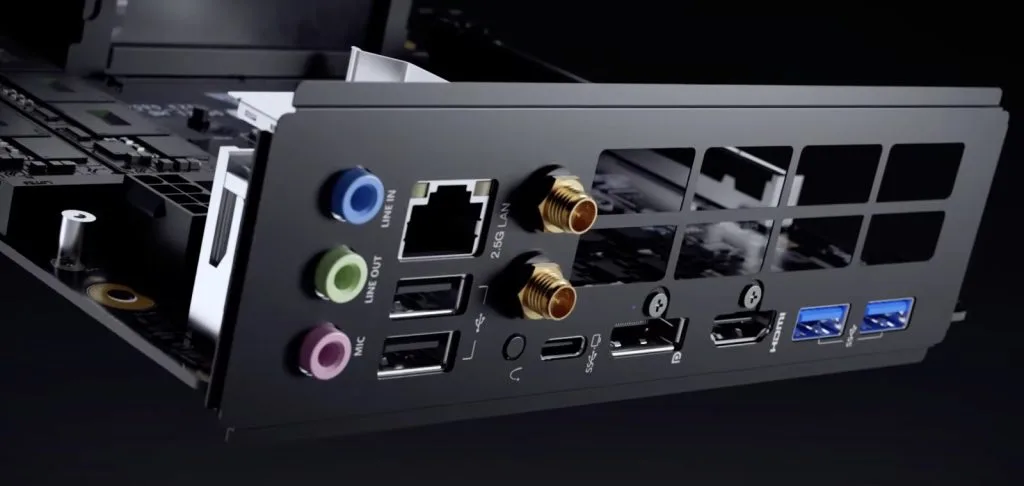

The inclusion of built-in WiFi 6E with robust antennas is a welcome upgrade from previous models where you had to provide your own wireless card.
One design choice that might divide opinions is the lack of SATA ports, which comes with a price premium of $150-200 over Minisforum’s non-X3D boards.
In my testing setup, I relied entirely on M.2 storage, but this could be a limitation for users with existing 2.5″ or 3.5″ drives.
Another notable omission is the lack of a front USB-C header, which could be problematic if your ITX case features a front Type-C port.
Installation and Setup Experience
Setting up the BD790i X3D was straightforward but came with a few quirks I should mention.
Since this is a barebones unit, I needed to provide my own memory, storage, and cooling fan.
For my test build, I used 16GB (2x8GB) of Kingston Fury DDR5-5600 SODIMM memory, a 1TB PCIe 5.0 Viper SSD, and a Noctua NF-F12 120mm fan for the CPU cooler.
Installing the SODIMMs was identical to laptop memory installation – straightforward and easy.
The M.2 SSDs went in without issue, though I did notice that the active cooling fan for the SSDs uses a very small connector that requires careful handling.
Several users have reported successful memory overclocking to 5600MT/s or even 6000MT/s with certain kits, often by booting with a single stick first, though success is not guaranteed and depends on both the RAM kit and BIOS version.
Mounting the Noctua fan onto the pre-installed CPU heatsink was simple using the provided brackets.
The biggest challenge I encountered was with the I/O shield – the Wi-Fi antenna bolts were quite stiff and blocked proper installation.
I actually had to remove the antenna bolts temporarily to get the I/O shield properly seated, then re-tighten them afterward – a quirk noted by several other users as well.
For my full testing setup, I paired the BD790i X3D with an AMD Radeon RX 7900 XT graphics card in an open test bench configuration to make swapping components easier.
I also tested with an NVIDIA RTX 5080 to ensure the board works well with top-tier GPUs from both manufacturers, which it handled without issue.
BIOS Features and Options
The Minisforum visual BIOS is clean and relatively easy to navigate.
Upon first boot, I spent some time exploring the available options.
Under the Advanced section, I found standard CPU configuration options including PSS support and NX mode.
The Hardware Monitor section allowed me to adjust fan curves, which I left at stock settings for initial testing.
In the AMD PBS section, I could adjust the PCIe slot settings – notably, the ability to set the graphics lane speed up to Gen 5.
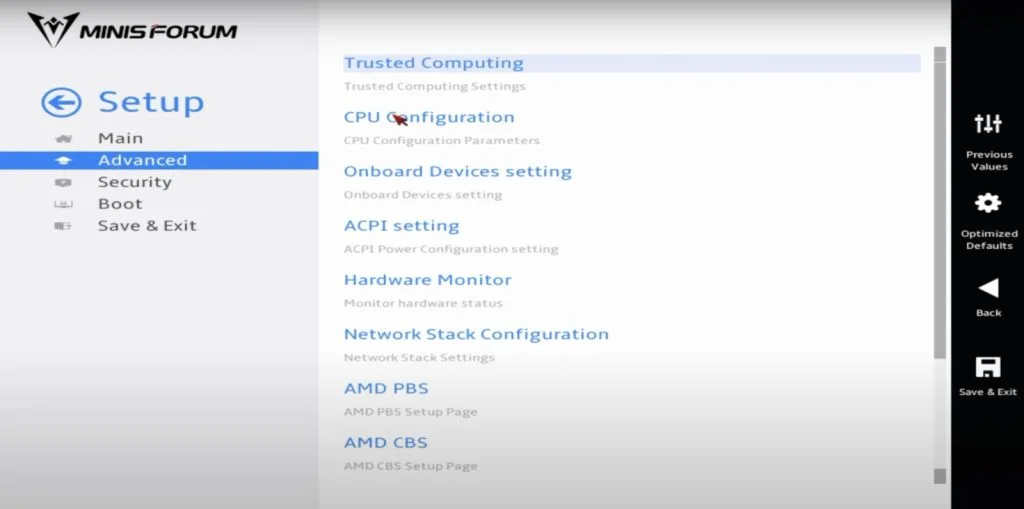

For my testing, I left this on Auto which correctly detected and utilized PCIe 5.0 for my graphics card.
Interestingly, I couldn’t find direct TDP adjustment options in the BIOS, though the system maintained a steady 100W sustained TDP during my testing with occasional boosts to around 120W under heavy loads.
An important note about the X3D variant is that it has a maximum temperature limit (TjMax) of approximately 89°C, compared to the non-X3D’s 100°C limit.
For most users, the default BIOS settings should be perfectly adequate, though enthusiasts might wish for more granular control over power and performance settings.
Performance Benchmarks
With everything set up, I was eager to see how this compact powerhouse would perform. Here’s what my testing revealed:
Geekbench 6
In Geekbench 6, the Ryzen 9 7945HX3D scored 2,801 in single-core and 16,043 in multi-core tests. For perspective, the Ryzen 9 7800X3D desktop chip typically scores around 3,300 single-core and 18,000 multi-core.
Considering this is a mobile chip running at a 100W TDP (versus 120W+ for desktop parts), these results are impressive and demonstrate the efficient performance of the 7945HX3D.
Cinebench R24
In Cinebench R24, the single-core score came in at 112, outperforming the Apple M1. The multi-core score reached 1,850, slightly higher than the standard 7940HX (1,789) without the 3D V-Cache.
These results confirm that the X3D variant offers modest performance improvements in synthetic benchmarks, with the real benefits more apparent in certain gaming scenarios.
3DMark Time Spy
When paired with the Radeon RX 7900 XT, the system achieved a Time Spy score of 24,354. Interestingly, this actually surpassed a similar system built with the desktop Ryzen 7 9800X3D and the same GPU, which scored 23,613.
While the graphics score was slightly lower with the 7945HX3D, the CPU score was significantly higher, resulting in a better overall result. This was a surprising finding that demonstrates how capable this mobile chip can be in the right conditions.
Gaming Performance
Gaming performance is where the X3D variant should theoretically shine, thanks to its enlarged L3 cache.
I tested several AAA titles at 1440p resolution, pairing the system with an NVIDIA RTX 5080 graphics card, to see how the system performed in real-world gaming scenarios.
Cyberpunk 2077
Running Cyberpunk 2077 at 1440p, the system managed an impressive 104 FPS average at native resolution (tested without DLSS or Frame Generation).
The Ryzen 9 7945HX3D CPU performed admirably, keeping up with the demands of this notoriously CPU-intensive title without creating a bottleneck for the powerful RTX 5080 used in this test setup.
Spider-Man 2
In Spider-Man 2 at 1440p with Very High settings (no ray tracing or FSR), the system delivered smooth gameplay with consistent framerates.
During this test, I monitored the power draw, which averaged around 89 watts for the CPU – slightly below the 100W sustained TDP rating.
Temperatures remained surprisingly manageable even during extended play sessions, with the CPU staying below 80°C with my Noctua cooling setup.
Forza Horizon 5
In Forza Horizon 5 at 1440p, the 7945HX3D and non-X3D versions initially seemed to perform almost identically, both delivering around 85 frames per second with near-identical settings.
However, after a fresh Windows installation on a new SSD, the X3D variant showed its true potential at 1080p, jumping to 184 FPS compared to the non-X3D’s 160 FPS – a 15% improvement that highlights the cache advantage in CPU-bound scenarios.
What was equally impressive was that the X3D achieved this performance while running 17°C cooler and using 20 watts less power than the standard 7945HX.
Black Myth: Wukong
Testing Black Myth: Wukong at 1440p showed the 7945HX and 7945HX3D delivering nearly identical frame rates at 85 FPS.
The real difference was in thermals and power consumption – the X3D version ran 17°C cooler while using 20 watts less power, essentially providing the same performance with significantly better efficiency.
At 4K resolution, the results were similar at 78 FPS, with the X3D variant maintaining its efficiency advantage.
Call of Duty: Black Ops 6
In Black Ops 6 at 1440p, the 7945HX3D actually pulled slightly ahead with 141 FPS versus the standard HX’s 139 FPS.
Again, the X3D achieved this while consuming 13 watts less power and running 11°C cooler than its non-X3D counterpart.
At 4K resolution, all CPU differences largely disappeared as the GPU became the limiting factor, with performance landing between 96-100 FPS across both the X3D and non-X3D variants.
Starfield
Starfield at 1440p Ultra settings ran beautifully on this setup.
I noticed the 7945HX3D maintained a consistent 5.2 GHz clock speed throughout gameplay, occasionally boosting to 5.4 GHz when needed.
This consistent high frequency, combined with the large L3 cache, resulted in smooth performance without the stuttering issues sometimes reported with lower-cache CPUs.
Monster Hunter Wilds
Monster Hunter Wilds at 1440p Ultra preset (FSR set to Quality, no frame generation) performed admirably as well, with the 7945HX3D and RX 7900 XT combination delivering a solid gaming experience.
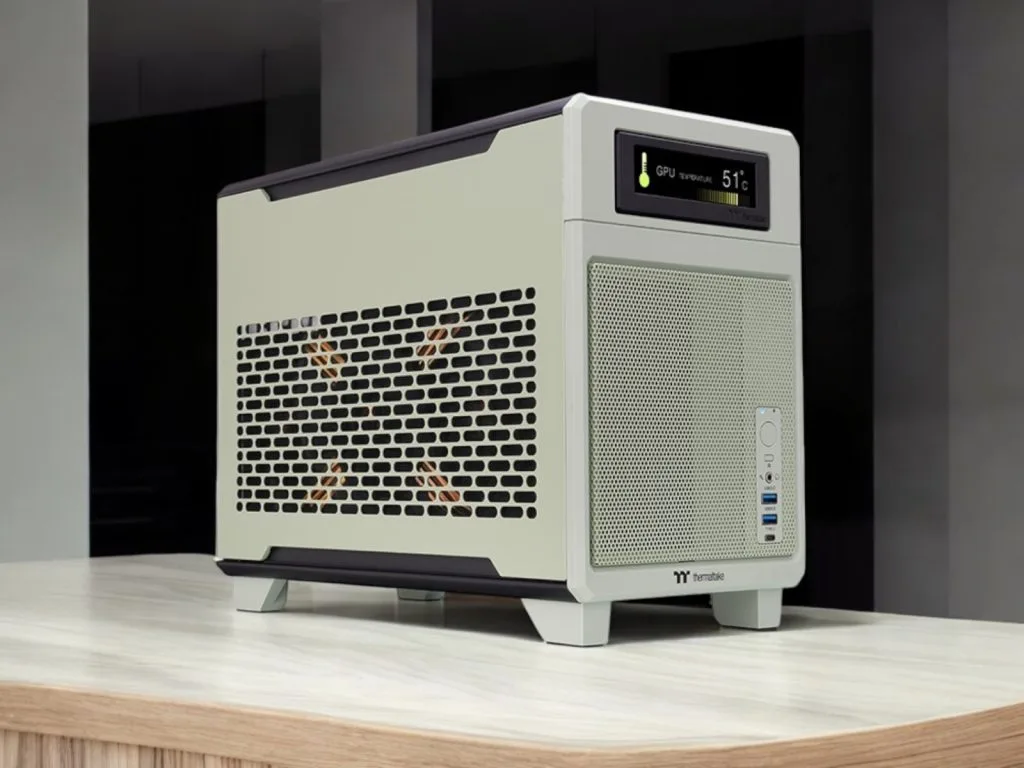

Planning a build? Don’t miss this case review:
Thermaltake TR100 SFF Review: A Few Things to Watch Out For
Thermal Performance and Power Consumption
Thermal management is critical for any small form factor build, so I paid close attention to temperatures and power draw during my testing.
With the Noctua NF-F12 fan installed on the CPU heatsink, I observed the following performance metrics:
- Maximum CPU clock: 5.436 GHz
- Average TDP while gaming at 1440p: ~93 watts
- Maximum recorded TDP: 123 watts
- Average CPU temperature during 1440p gaming: ~74°C
- Maximum recorded temperature: 86°C (approaching the X3D’s ~89°C TjMax limit)
It’s worth noting that my testing was done in an open-air test bench.
In a closed case, you might need to adjust the fan curve to achieve similar temperatures, but the cooling solution proved more than adequate for the 100W TDP of the 7945HX3D.
An important distinction between the X3D and non-X3D variants is that the 7945HX3D has a maximum temperature limit (TjMax) of approximately 89°C, compared to the standard 7945HX’s 100°C limit.
When comparing the X3D variant to the standard 7945HX in similar conditions, I found that the X3D version consistently ran 10-17°C cooler while using 10-20 watts less power for comparable performance.
This efficiency advantage is significant for SFF builds where thermal management is always a challenge.
For cooling, I tested multiple 120mm fan options including the Noctua NF-F12, Noctua NF-A12x25, and the Arctic P12 Max.
Each has different noise/performance characteristics, but all were capable of keeping the 7945HX3D well within its thermal limits.
Comparison with Other Minisforum Boards
Having tested several Minisforum boards in the past, I can provide some context on how the BD790i X3D compares to its siblings:
BD790i X3D vs. BD795 SE
The BD795 SE features the standard Ryzen 9 7945HX (without 3D V-Cache). In gaming tests at 1440p, both boards deliver very similar frame rates in most titles, but the X3D variant consistently runs 12-17°C cooler while consuming 14-20 watts less power.
This efficiency advantage becomes more noticeable in CPU-limited scenarios, such as 1080p gaming or specific titles that benefit from the larger cache.
The X3D variant also includes WiFi 6E and Bluetooth 5.3 built-in, whereas the SE model requires you to add your own wireless card.
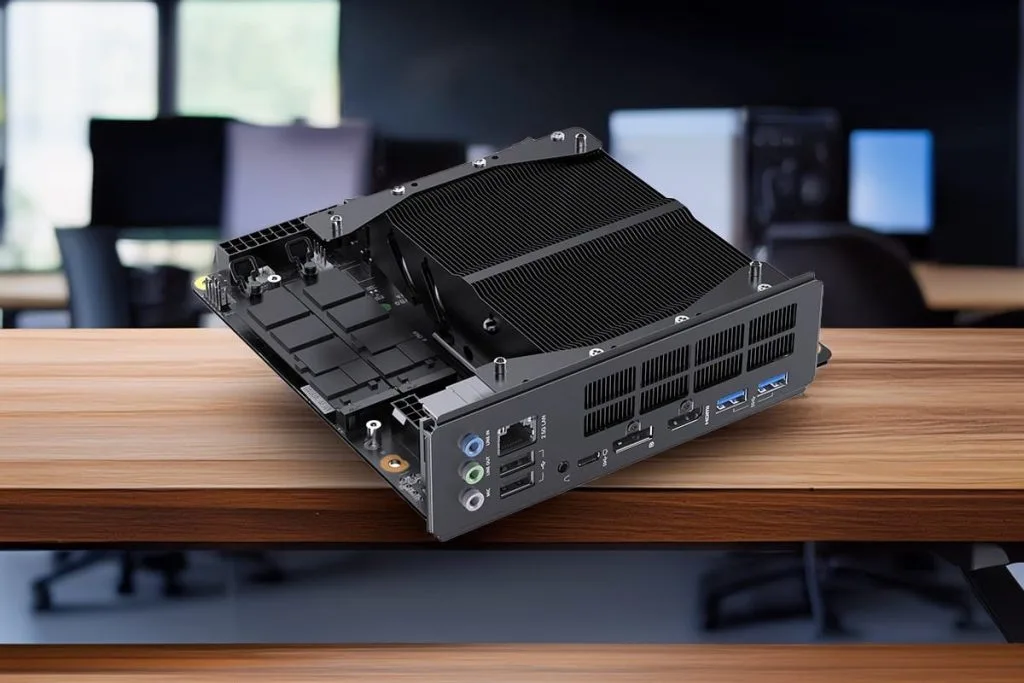

You might also like:
Minisforum BD795M & BD795i SE Review: Should You Build a PC With Them?
BD790i X3D vs. BD795M
The BD795M is a micro-ATX board with the standard 7945HX. Beyond the form factor difference, the main distinctions are:
- The BD795M features PCIe 4.0 instead of 5.0
- The BD795M includes SATA ports which the BD790i X3D lacks
- The BD795M does not include an integrated WiFi/Bluetooth solution
- The BD795M does not include a pre-installed CPU cooler
For users who need SATA connectivity or prefer the larger micro-ATX form factor, the BD795M remains a solid option at a lower price point. However, the BD790i X3D offers better future-proofing with PCIe 5.0, integrated wireless connectivity, and the efficiency benefits of the X3D processor.
Benefits of the X3D Technology
The “X3D” in the 7945HX3D refers to AMD’s 3D V-Cache technology, which adds an additional layer of L3 cache to the processor. The standard 7945HX has 64MB of L3 cache, while the X3D variant boasts 128MB.
In my testing, this additional cache delivered three main benefits:
- Improved efficiency: The X3D variant consistently used less power while delivering similar or better performance
- Lower temperatures: With less power consumption comes reduced heat output, allowing for quieter cooling solutions
- Smoother gameplay: In CPU-limited scenarios, the larger cache helps reduce stuttering and provides more consistent frame times
While synthetic benchmarks showed modest improvements, the real-world benefits of the X3D technology were most apparent in gaming scenarios, particularly at lower resolutions where the CPU becomes more of a limiting factor.
In some games like Forza Horizon 5 at 1080p after a clean Windows installation, I saw up to a 15% performance improvement with the X3D variant over the standard model.
When paired with a high-end GPU like the RX 7900 XT at 1440p or 4K, the system becomes more GPU-bound, somewhat masking the advantages of the X3D cache.
However, the efficiency benefits remain significant regardless of resolution, with the X3D variant consistently using less power and running cooler than its non-X3D counterpart.
It’s worth noting that after a fresh Windows installation on a new SSD, some games showed more pronounced performance gains from the X3D cache, suggesting that optimal software configuration can help maximize the benefits of this technology.
Pros and Cons
Pros
- Excellent performance: The 7945HX3D delivers desktop-class performance in a mobile CPU package
- Energy efficiency: Lower power consumption than equivalent desktop CPUs
- Future-proof connectivity: PCIe 5.0 for both GPU and storage
- Integrated WiFi 6E and Bluetooth 5.3: No need for additional wireless cards
- Pre-installed CPU and cooler: Simplifies the building process
- Compact form factor: Perfect for SFF builds
- Thermal performance: Runs cooler than non-X3D variants
Cons
- No SATA ports: Reliance on M.2 storage only
- Memory speed limitation: Official support tops out at 5200MT/s
- Premium price: $200 more than non-X3D variants
- Limited USB ports: Could use more rear I/O options
- Non-upgradeable CPU: CPU is soldered to the motherboard
- User-supplied fan required: Need to add your own 120mm fan for CPU cooling
Who Should Buy the Minisforum BD790i X3D?
After extensive testing, I believe the BD790i X3D is ideally suited for:
- SFF enthusiasts: If you’re building in a compact case where thermal management is challenging, the efficiency of the X3D variant is a significant advantage
- Gamers seeking a compact powerhouse: When paired with a powerful GPU, this board delivers excellent gaming performance without the heat output of desktop alternatives
- Content creators on the go: The 16-core processor handles video editing and rendering tasks admirably in a portable package
- Users who value efficiency: The lower power consumption and heat output make this an excellent choice for quieter builds or situations where power efficiency is important
Who Should Not Buy the Minisforum BD790i X3D?
On the other hand, the BD790i X3D might not be the best choice for:
- Users on a tight budget: The premium for the X3D variant may not be justified if you’re price-sensitive
- Those needing SATA storage: The lack of SATA ports means relying entirely on M.2 storage
- Enthusiasts who frequently upgrade CPUs: Since the CPU is soldered to the motherboard, future processor upgrades would require a complete board replacement
BD790i X3D: Making The Right Choice
Every PC component represents a balance of features, performance, and price. The Minisforum BD790i X3D excels in specific usage scenarios while presenting limitations in others. Consider these aspects to determine if it aligns with your particular needs.
Key Advantages
- Superior Thermal Efficiency — Runs 10-17°C cooler than non-X3D models during gaming workloads
- Lower Power Consumption — Uses 10-20W less power while delivering similar performance
- 128MB L3 Cache — Double the cache of standard models for better gaming in CPU-limited scenarios
- PCIe 5.0 Support — Future-proof for next-gen GPUs and storage devices
- Integrated WiFi 6E + BT 5.3 — No need for additional wireless cards
- Superb SFF Performance — Desktop-class performance in compact form factor
Limitations to Consider
- Price Premium — $150-200 more expensive than non-X3D variants
- No SATA Connectivity — Storage limited to M.2 NVMe drives only
- Non-Upgradeable CPU — Processor is permanently soldered to the board
- Limited USB Ports — Fewer USB connections than typical desktop boards
- No Front USB-C Header — Incompatible with cases featuring front Type-C ports
- Special Cooling Required — Not compatible with standard coolers; needs specific 120mm fan setup
Ideal User Profiles
SFF Enthusiasts
Perfect for those building in compact cases where thermal efficiency and power constraints matter. Lower temps and power use translate to quieter operation in confined spaces.
Performance Gamers
Ideal for gamers who plan to pair with high-end GPUs. The X3D cache provides advantages in certain titles, especially at 1080p where CPU limitations are more evident.
Content Creators
Multi-core performance handles video editing and rendering workloads admirably, while PCIe 5.0 NVMe drives accelerate file transfers and project loading times.
Budget-Conscious Builders
Not recommended if cost is a primary concern. The standard BD790i or BD795M offer nearly identical multi-core performance for significantly less money.
Storage-Heavy Users
Absence of SATA ports limits storage options to M.2 NVMe drives only. Consider the BD795M for those needing to connect multiple SATA drives for media servers or storage arrays.
Frequent Upgraders
Not suitable for those who like to upgrade components regularly. The soldered CPU means the entire motherboard must be replaced for future processor upgrades.
Frequently Asked Questions
Is Minisforum BD790i X3D worth it?
The BD790i X3D is worth the investment if you value efficiency, lower temperatures, and PCIe 5.0 connectivity. The price premium over non-X3D variants is significant, but the performance-per-watt and thermal advantages make it a compelling option for small form factor builds.
How does BD790i X3D compare to 7800X3D?
The 7800X3D desktop CPU offers higher single-core performance and slightly better gaming results in CPU-limited scenarios due to its single-CCD design with lower core-to-core latency.
However, the 7945HX3D provides 16 cores versus 8 cores in the 7800X3D, making it significantly superior for multi-threaded workloads like rendering and video encoding.
In Blender and other multi-core benchmarks, the 7945HX3D outperforms not only the 7800X3D but also comes surprisingly close to some desktop Ryzen chips.
The 7945HX3D also offers better efficiency with its 100W TDP versus the 7800X3D’s 120W, making it potentially more suitable for small form factor builds with limited cooling capacity.
In my testing, the BD790i X3D delivered comparable gaming performance to desktop alternatives while consuming less power and generating less heat.
What RAM for Minisforum BD790i X3D?
The BD790i X3D requires DDR5 SODIMM memory modules (laptop-style).
While officially supporting speeds up to 5200MT/s, I found that 5600MT/s kits work well, though they’ll default to 5200MT/s without tweaking.
Some users have reported successful memory overclocking to 5600MT/s or even 6000MT/s with certain kits, often by first booting with a single stick before adding the second.
In particular, Kingston Fury and Crucial DDR5 SODIMMs have shown good compatibility with this board.
For optimal performance, I recommend 32GB (2x16GB) or more of DDR5-5200 or better, with the understanding that memory overclocking success isn’t guaranteed.
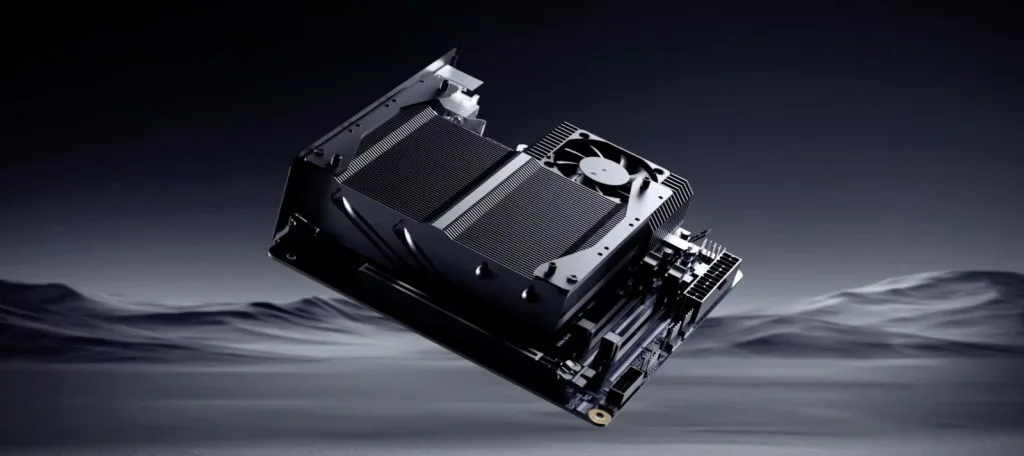

Can you overclock BD790i X3D?
Traditional overclocking options are limited in the BIOS. However, there are options to adjust memory speeds beyond the official 5200MT/s limit. The CPU itself will automatically boost up to 5.4GHz based on thermal and power headroom. In my testing, the chip consistently maintained high boost clocks with adequate cooling.
Minisforum BD790i X3D temperature?
With a quality 120mm fan like the Noctua NF-F12, I recorded average temperatures of around 74°C during gaming, with peaks of 86°C under sustained full load. This is impressive for a 16-core processor in a compact form factor. The X3D variant runs 10-15°C cooler than the standard 7945HX in similar conditions.
What GPU for BD790i X3D?
The PCIe 5.0 x16 slot supports any modern GPU. I tested with an AMD Radeon RX 7900 XT with excellent results. For a balanced build, I recommend GPUs ranging from RTX 4070/RX 7800 XT up to RTX 4090/RX 7900 XTX, depending on your budget and case size constraints.
BD790i X3D power consumption?
The CPU maintains a 100W sustained TDP during typical workloads, with occasional boosts to around 120W.
During gaming, I observed an average power draw of approximately 93W.
The X3D variant consistently consumes 10-20W less than the standard 7945HX while delivering similar or better performance.
This efficiency advantage is particularly notable in games like Black Myth: Wukong, where the X3D variant used 20W less power while delivering identical frame rates.
If power efficiency is a priority, the X3D variant offers a significant advantage over both the standard 7945HX and many desktop alternatives.
Best fan for BD790i X3D?
After testing several options, I found the Noctua NF-F12 to be the ideal cooling fan for this board.
It provides excellent static pressure for pushing air through the heatsink while maintaining reasonable noise levels.
The Noctua NF-A12x25 is another excellent option that offers a better balance of airflow, static pressure, and noise, though at a higher price point.
For those on a budget, the Arctic P12 Max is a good alternative with similar performance at a lower price point.
Whichever fan you choose, remember that you must supply your own as it’s not included with the motherboard.
Does BD790i X3D support PCIe 5.0 SSD?
Yes, the BD790i X3D features two M.2 2280 slots with PCIe 5.0 x4 support, capable of accommodating the latest high-speed SSDs. Both slots are equipped with active cooling to prevent thermal throttling. In my testing with a PCIe 5.0 SSD, I achieved read speeds over 12,000 MB/s.
What case for Minisforum BD790i X3D?
Any mini-ITX compatible case should work, but consider the height of the CPU cooler with fan (approximately 60mm). I’ve had success with cases like the Cooler Master NR200, Fractal Design Ridge, and SSUPD Meshlicious. For ultra-compact builds under 8 liters, verify clearances carefully.
Does BD790i X3D have SATA ports?
No, the BD790i X3D does not include any SATA ports. Storage is limited to the two M.2 NVMe slots. If you need SATA connectivity, consider the BD795M model instead, which offers two SATA 3.0 ports but comes with PCIe 4.0 rather than 5.0.
Conclusion
After extensive testing, I’ve found the Minisforum BD790i X3D to be an impressive piece of engineering that successfully bridges the gap between mobile and desktop computing.
The combination of a powerful 16-core processor with 3D V-Cache technology in a mini-ITX form factor opens up new possibilities for small form factor builds that don’t compromise on performance.
The efficiency advantages of the X3D variant are clear – lower power consumption, reduced heat output, and comparable or better performance than the standard model.
These benefits are particularly valuable in compact cases where thermal management is challenging.
After a fresh Windows installation, CPU-bound games at 1080p showed up to 15% better performance compared to the non-X3D variant, highlighting the benefits of the enlarged cache in certain scenarios.
The inclusion of PCIe 5.0 for both the GPU and storage, along with integrated WiFi 6E and Bluetooth 5.3, ensures this board is well-equipped for future hardware developments.
The primary drawbacks are the premium price (approximately $150-200 more than non-X3D variants), the lack of SATA ports, missing front USB-C header, and the fact that the CPU cannot be upgraded separately from the motherboard.
With its lower TjMax of 89°C compared to the non-X3D’s 100°C, proper cooling is essential, though the X3D inherently runs cooler than its counterpart.
Whether it’s worth the premium over the standard models depends on your specific needs and budget, but there’s no denying that the BD790i X3D represents an exciting direction for mini-ITX computing.


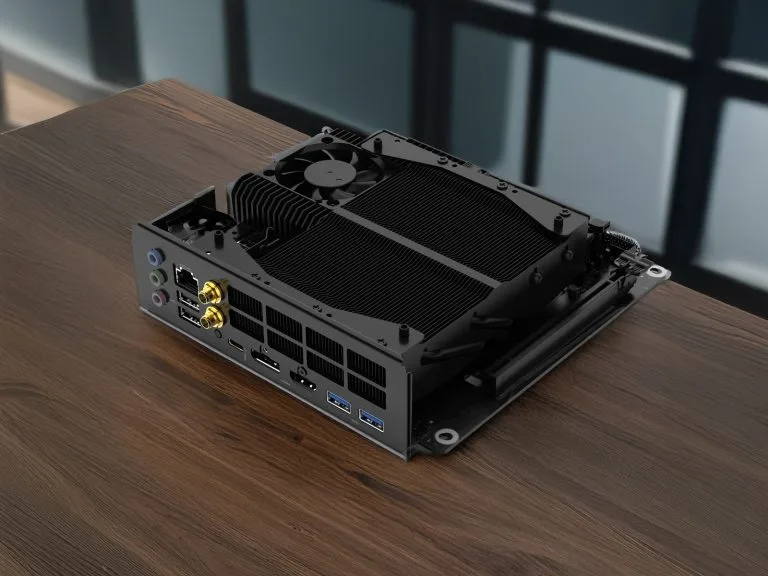

Do have any recommendations about DPC latency, as the other Minisforum 790/795 (770 funnily not, but not available anymore) mainboards showed weaknesses and definitely ruled out usage as a DAW or with other latency focused applications.
Hey Stefan! Thanks for bringing up DPC latency, it’s not something I typically include in my standard review process.
From what I’ve seen of previous Minisforum boards, the latency issues you mentioned are a legitimate concern. The X3D has that mobile CPU architecture, integrated WiFi/BT, and limited BIOS tweaking options – all potential red flags for both audio work and other real-time applications.
I wouldn’t personally recommend it for serious DAW use or any latency-sensitive tasks without confirmed testing. If there’s enough interest, I might try to get a unit back specifically to run LatencyMon tests.
Appreciate you raising this point – it’s valuable info for both audio folks and anyone working with real-time applications!
Thanks for your reply! I have the impression, that these more and more powerful mini PCs could be a viable alternative for creators, especially with the arrival of the brand-new AI APU (AMD Strix Halo). My general assumption is, that these machines tend to lack some fine tuning to save development costs (which is understandable, but an annoying fact due to unnecessary performance loss).
In most cases reasons seem to be very basic Bios’es, lousy Windows stock installations (often bloated, sometimes including malware) and outdated driver’s that cause hiccups.
WiFi and Bluetooth components though could be physically removed or deactivated in Bios to improve typical DAW pitfalls (as you mentioned). But that alone could lead a lot of potential customers to the conclusion, that Apple Silicone is the safer way to go.
I personally would appreciate if you would include this latency issue into your test suite in the future, but is not necessary to recall this specific unit, as there are a lot of promising machines in the pipeline !👍
Really appreciate you sharing that, Stefan. You’re absolutely right, these mini PCs have so much potential, but yeah, the little stuff like BIOS and drivers can make a big difference. I’ll keep an eye on that for future reviews!
Thanks for the review.
Does BIOS support adjusting tjmax for x3d and non-x3d versions? Let’s say I want max temp = 80°
Hi Yurik, sorry, but I didn’t see any TjMax adjustment options in the BIOS when I tested either board and I don’t have one on hand to double-check. Maybe a future BIOS update will add that setting. Cheers!